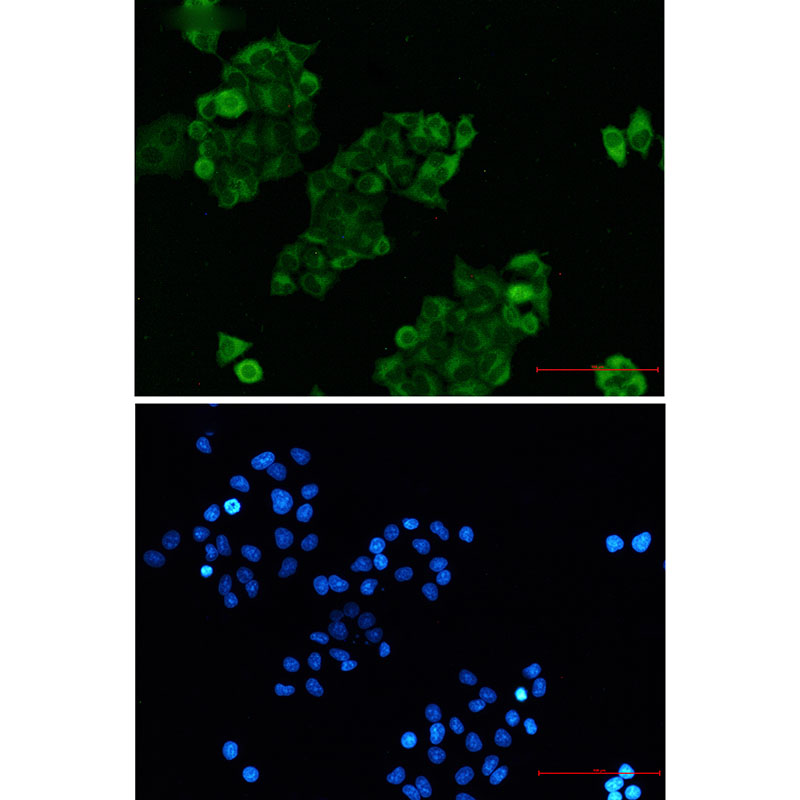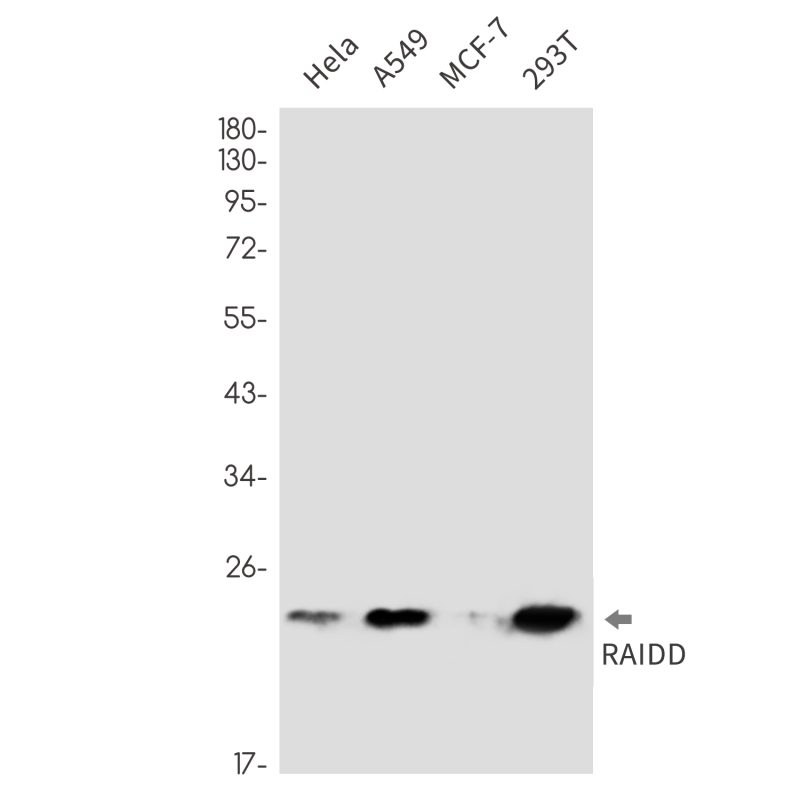

| WB | 1/500-1/1000 | Human,Mouse,Rat |
| IF | 1/20 | Human,Mouse,Rat |
| IHC | 咨询技术 | Human,Mouse,Rat |
| ICC | 1/50-1/200 | Human,Mouse,Rat |
| FCM | 咨询技术 | Human,Mouse,Rat |
| Elisa | 咨询技术 | Human,Mouse,Rat |
| Aliases | CRADD; MGC9163; RAIDD; Death adaptor molecule RAIDD; Death domain containing protein CRADD |
| Entrez GeneID | 8738 |
| WB Predicted band size | Calculated MW: 23 kDa; Observed MW: 23 kDa |
| Host/Isotype | Rabbit IgG |
| Antibody Type | Primary antibody |
| Storage | Store at 4°C short term. Aliquot and store at -20°C long term. Avoid freeze/thaw cycles. |
| Species Reactivity | Human |
| Immunogen | A synthetic peptide of human RAIDD |
| Formulation | Purified antibody in TBS with 0.05% sodium azide,0.05%BSA and 50% glycerol. |
+ +
以下是3篇涉及RAIDD抗体的关键文献信息,涵盖其功能研究和应用方向:
---
1. **文献名称**: *Identification of RAIDD as a regulator of apoptosis*
**作者**: Duan H, Dixit VM
**摘要**: 本研究首次克隆并鉴定了RAIDD蛋白,发现其通过死亡结构域(death domain)与RIP和Caspase-2相互作用,揭示了其在Caspase-2激活级联中的关键作用。实验中采用RAIDD特异性抗体验证了其在细胞凋亡中的表达定位。
2. **文献名称**: *Role of RAIDD in the TNF-induced apoptotic pathway*
**作者**: Ting AT, Pimentel-Muiños FX
**摘要**: 通过免疫共沉淀(使用RAIDD抗体)和基因敲除技术,证实RAIDD在TNF-α介导的凋亡信号中连接RIPK1与Caspase-2.并发现其磷酸化修饰影响凋亡体组装效率。
3. **文献名称**: *RAIDD overexpression exacerbates β-amyloid-induced neurodegeneration*
**作者**: Shankar GM, et al.
**摘要**: 在阿尔茨海默病模型中,利用RAIDD抗体进行免疫组化分析,发现RAIDD在神经元中异常聚集,并通过激活Caspase-2加剧β-淀粉样蛋白毒性,提示其作为治疗靶点的潜力。
---
**备注**:上述文献方向覆盖RAIDD的基础机制(信号通路、蛋白互作)及疾病关联研究(神经退行性疾病),相关抗体多用于蛋白互作验证(如Co-IP)或病理模型中的表达检测(如Western Blot/免疫组化)。如需具体实验细节(如抗体品牌、货号),可进一步补充说明。
RAIDD (RIP-associated ICH-1/CED-3 homologous protein with a death domain), also known as CRADD (CASP2 and RIPK1 domain-containing adaptor with death domain), is an adaptor protein involved in apoptosis and inflammatory signaling. It contains two functional domains: a C-terminal death domain (DD) that interacts with RIPK1. and a caspase recruitment domain (CARD) that binds caspase-2. RAIDD plays a critical role in assembling the PIDDosome complex by bridging interactions between PIDD (p53-induced protein with a death domain) and caspase-2. thereby activating caspase-2-mediated apoptosis in response to DNA damage or cellular stress.
Antibodies targeting RAIDD are essential tools for studying programmed cell death mechanisms, particularly in contexts like cancer, neurodegenerative diseases, and developmental biology. They enable researchers to detect RAIDD expression levels, investigate its interaction partners (e.g., PIDD, caspase-2), and explore its regulatory roles in apoptosis versus necroptosis pathways. Commercially available RAIDD antibodies are typically validated for applications such as Western blotting, immunohistochemistry, and co-immunoprecipitation. Recent studies also implicate RAIDD in non-apoptotic processes, including NF-κB signaling and inflammation, expanding its potential therapeutic relevance. However, some challenges persist, including antibody specificity verification due to structural similarities among DD/CARD-containing proteins.
×